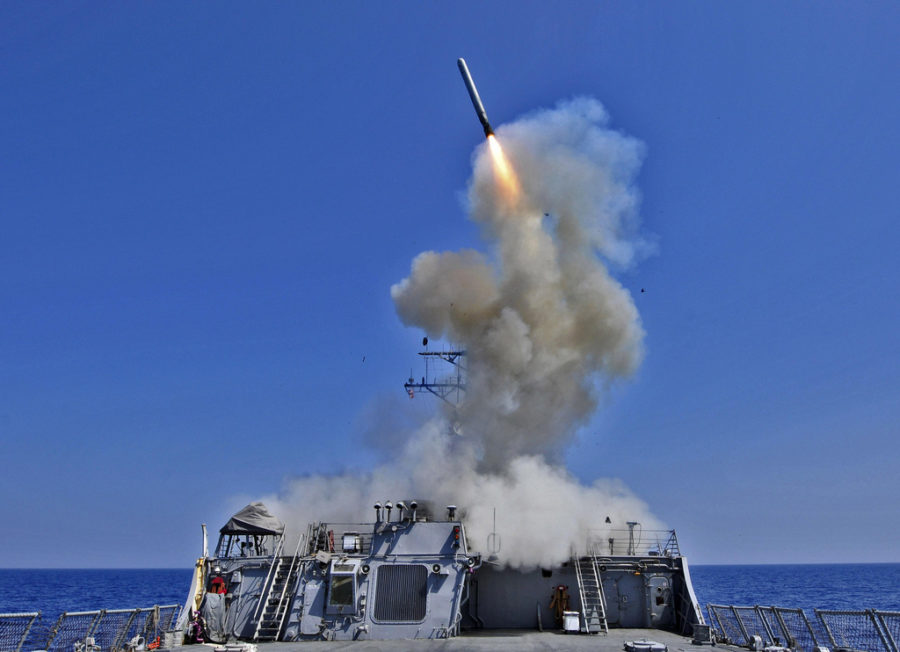Trump Makes a Thump in the Middle East
USS Barry fires a Tomahawk missile. Labeled for reuse under Flickr Commons.
Boom! Boom! Boom! Boom! Boom! Boom! Boom! Boom! Boom! Boom! Boom! Boom! Boom! Boom! Boom! Boom! Boom! Boom! Boom! Boom! Boom! Boom! Boom! Boom! Boom! Boom! Boom! Boom! Boom! Boom! Boom! Boom! Boom! Boom! Boom! Boom! Boom! Boom! Boom! Boom! Boom! Boom! Boom! Boom! Boom! Boom! Boom! Boom! Boom! Boom! Boom! Boom! Boom! Boom! Boom! Boom! Boom! Boom! Boom! That’s the sound of democracy knocking on Assad’s door.
On the morning of April 6th, the US launched 59 Tomahawk cruise missiles aimed at the Shayrat Airbase in Syria. This airbase, controlled by the government, is believed to have been used to launch the Khan Shaykhun chemical attack that occurred on April 4th and killed more than 80 people in the Syrian providence of Idlib, including children. The US government and several other governments around the world attribute the chemical attack to the forces of Syrian President Bashar al-Assad. This use of chemical weapons is what prompted the United States to launch the missile strike.
President Donald Trump justified the strike in a short statement after the attack, where he said, “It is in this vital national security interest of the United States to prevent and deter the spread and use of deadly chemical weapons.” Yet, the effectiveness and necessity of the missile strike is ambiguous. Initial US reports claimed that 58 out of 59 of the cruise missiles “severely degraded or destroyed” their intended targets: air defenses, aircraft, hangars, and fuel. Following the airstrike, Secretary of Defense James Mattis claimed that the airstrike destroyed approximately 20% of the Syrian government’s operational aircraft. According to the Russian defense ministry, however, only 23 missiles hit the base, and it does not know where the remaining 36 landed. Because of these conflicting statements, the actual effectiveness of the airstrike is questionable.
At least part of Russia’s claim on the ineffectiveness is likely to be true because the airbase appeared to be operational only hours after America’s attack. Some observers believe that the ineffectiveness was due to the fact that America notified Russia prior to the strike in order to reduce Russian casualties; these observers consider it probable that Russia passed information of the attack to the Syrian government, allowing planes to be relocated to another airbase. Despite this possibility, the message of this missile strike was clear: the use of toxic chemical weapons will not be permitted. By targeting the same airbase believed to have been the origin of the gas attack, the United States reinforces this message directly to President Assad.
Although, this attack raises the question: where do we go from here? President Trump has not released a clear, long-term strategy for US involvement in the Middle East. The realistic objectives of the missile attack are therefore quite unknown. If bombs and guns were the solution to the raging conflict in the Middle East, then the US would have solved the conflict and retreated from Afghanistan and Iraq and Syria years ago. Perhaps a period of slight isolationism where we solve problems inside the country while maintaining moderate support for allies such as Israel should be in order.
The response to the attack has been mostly positive, especially from international allies, but the strike damages US-Russia relation, and China has also opposed the strike. The strike also met varying support from members of the US Government as well as its citizens. Some members of Congress like House Speaker Paul Ryan and House Minority Leader Nancy Pelosi believe the attack was an appropriate and justified response to Assad’s use of chemical weapons. Other representatives like Seth Moulton and Steve Russell criticized the president’s actions, which they believe lacked a clear objective.
Another factor that makes questionable the necessity of the airstrike is the price tag. The total price of the missiles is estimated to be around $60 million. Some members of the public believe that this was not money well spent, especially since President Trump ran his campaign on promises to avoid entering conflict in the Middle East. That $60 million could have gone towards improving life in the states, but instead it helped escalate a war that the US should have no part of.

Shalom le'kulam, my name is Jonathan Flat and I am the Managing Editor for this outstanding school newspaper. As a 16-year-old in the 12th grade, I'll...














Lauren Berg-Perlow • Apr 17, 2017 at 12:57 pm
BOOM! that was a great article.
Whitney Moran • Apr 17, 2017 at 12:31 pm
Hoping to see Trump remain true to his campaign promises and stay out of unneeded Middle Eastern Conflict. Great article Jonathan!
Robert Corl • Apr 17, 2017 at 12:17 pm
While I wholeheartedly disagree with the Orange Man on several topics, I am at least glad that he followed up on Obama’s previous attempts of threatening Syria and then not acting on them.
Calvin Yocum • Apr 17, 2017 at 12:14 pm
Things have escalated to extremely high tensions as of late, hopefully the United States will be able to stear clear of any possible developments.
Carter Rodny • Apr 17, 2017 at 12:12 pm
@JosephCordaro Take a closer look Joe. It was actually 59 booms.
#HereComestheBoom
Luke Negley • Apr 17, 2017 at 12:03 pm
#Can’tStumpTheTrump
Joseph Cordaro • Apr 17, 2017 at 11:58 am
Great article Jonathan. I liked the 58 booms at the start. But it does raise questions of our relations of other countries. Obviously there is a bigger reason for attacking. In my opinion, the United States should remain isolated from outside conflicts and focus on forming better relations to boast for better and bigger business in our own lands.
Jake Werner • Apr 17, 2017 at 11:56 am
While the attack was justified and I believe that we should have done something after the chemical attacks, we probably should not be getting involved with Syria, especially since tensions with North Korea is on the rise. Nice article!